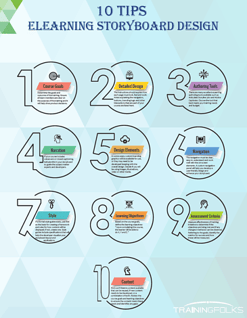How To Create Engaging eLearning: 6 eLearning Best Practices

You’re probably aware of the difference a well-trained workforce can make to the success of your business. The better everyone is at their job, the more everything works in harmony. The result is often an improved bottom line.
A trained workforce isn’t necessarily one that has acquired many years of formal education. The essential element is that each employee becomes competent in what they do.
Engaging eLearning is a great option for on the job training, as employees can learn on the go when and where they need to. But, how do you ensure your employee is successfully learning while staying engaged?
Benefits of eLearning
Training a new employee on the job is one of the most effective ways of educating them on performing various tasks within their role.
The training is delivered online, and the learner can study from a desktop, laptop, smartphone, or tablet – at any location they want.
This makes it easy for learners to go over the information on their own personal devices if they so choose. They can review the lessons anywhere and at any time.
Creating Engaging eLearning
A challenge with any type of learning effort is to keep the learner engaged enough to progress and learn from the course. Learning anything new requires effort, but if you keep your learners engaged, they will see it as an opportunity rather than an obstacle. Your course should stimulate and challenge learners rather than making them feel overwhelmed.
Find below our 6 tips for keeping your learners engaged:
1. Know your learners.
You must know your audience. Create a customer avatar, or idealized profile, about your ideal student. In other words, designed the course for the group you are teaching.
If the course is for the sales team, include examples of how to deal with customer objections. If the course is to teach a salesperson how to close a sale, then include examples of what they should say under different circumstances.
2. Set a learning objective
Make it clear what value the course offers. When a learner has a clear idea of how the course will improve the quality of their life, they will be more interested in comprehending, memorizing, and using the information.
We are all motivated by self-interest, so if the learner sees how they will benefit from the information, they will be more eager to consume it. The learning objective should be something that sparks interest in your learner. You will never have engaged learners if the reason they are taking the course is: ‘do this training module because I said so…’
3. Design an interactive course.
People learn best by doing something hands-on. The fastest way to learn anything is to practice or interact with the information. Creating a custom eLearning course also ensures interactivity as the course is specific and relatable to your organization.
It doesn’t matter how many bicycle books you read or videos you watch about learning how to ride a bike, you will never know how to ride one until you climb on your bike and try it!
You can even make abstract information more understandable. For instance, you can use quizzes to make the information more interactive. Also, consider using gamification to make it more fun to learn the new material. Creating an interactive eLearning module ensures engagement and entices the user to progress further.
4. Keep the modules short.
Break large tracts of information into shorter segments. This simple technique reduces boredom. It’s also important to stick to the point rather than supplying unnecessary information.
Leave the learner feeling that they have grasped an important concept after going through a module. In this way, as they journey from one module to another, they can build upon ideas they learned in earlier modules.
When someone feels that they have learned something, they are motivated to continue. If they feel bewildered or overwhelmed they are more likely to procrastinate studying the material.
5. Make the information easier to understand.
You can make the information easier to understand using visuals, such as graphics, videos, images, and animations.
The use of multimedia will appeal to different types of learners.
People learn in one of three ways:
- Some people learn best when they see the information. These are visual learners.
- Some people learn best when they hear the information. These are auditory learners.
- Some people learn best when they can interact in a physical way with the information. These are kinesthetic learners.
6. Improve readability scores
Using a readability formula like Flesch Kincaid will help you simplify your vocabulary and sentence structure. The easier it is for your audience to go through your written material, the more they will be able to get out of your course.
Even if your audience has an advanced educational background, they will appreciate the benefit of shorter sentences as this will help them understand the concepts at a faster rate.
Creating engaging eLearning can be easier than you think with the right planning!
Get our FREE Download: '10 Tips for eLearning Storyboard Design'


